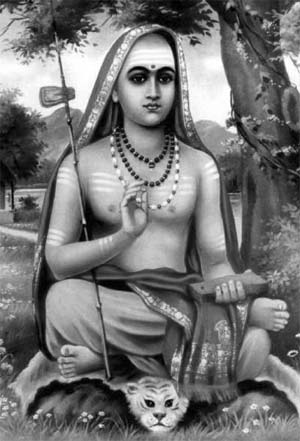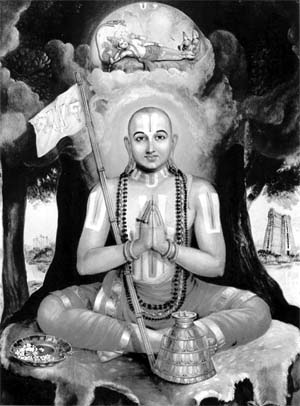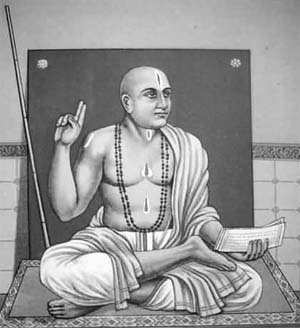Apr 17, 2024
Apr 17, 2024
Vedanta is the basis of Hinduism. It asserts that Brahman, the 'impersonal' God and the universal soul, is the Absolute Truth. Brahman has multiple roles to play: the creator, the maintainer, and the destroyer all in one. (This can be viewed as the origin of the trinity Gods namely Brahma, Vishnu, and Shiva, respectively). Vedanta states that the individual human soul (jiva-atman) originates and merges with the Brahman (cosmic soul- Parama-atman). There are three different philosophies on this concept.Advaita (non-duality or monism) implies that Brahman and Jiva-atman are identical, while Dvaita (duality) differs from Advaita and maintains an ultimate diversity between Brahman and Jiva-atman. Vishishtadvaita (qualified non-duality or qualified monism) maintains a crucial differentiation as well as a fundamental identity. Shankara's Advaita Philosophy Ramanuja's Vishishtadvaita Philosophy Madhva's Dvaita Philosophy Knowledge can be obtained through perception, inference and the Vedas. (Pratyaksha, Anumana and Pramana). The universe is as real as God. Difference and diversity are the central characteristics of Reality. Maha Vishnu is the Supreme Being. All the other deities are subordinates in a strictly organized hierarchy. Vayu is the mediator between God and individual souls. God is the creator, sustainer and the destroyer of the universe. He also is the governor of moral and natural laws of the universe and is the remover of ignorance and giver of enlightenment. He can dissolve the bondage of cycle of births and rebirths (samsara) and grant eternal salvation. He causes the eternal cosmic cycle of dissolution of the universe and creation of a new one.
Sri Shankaracharya from Kerala, Sri Ramanujacharya from Tamil lands and Sri Madhvacharya from Karnataka, expounded the advaita, vishishtadvaita and dvaita philosophies respectively. In a span of five hundred years three great Acharyas from the South arose to change the direction of Hindu religion. On the surface, all three appear to have opposing views but the great quality of Hindu philosophy is one of assimilation. The three theories of monism, qualified monism and dualism were synthesized, as branches of the same religion, Hinduism. Based on the metaphysical system,Shankara (circa 788-820 C.E.) believed in radical monism called Advaita. Shankara, born to an orthodox Brahmin from Kalati, Kerala on the banks of River Poorna, was a child prodigy. He mastered the Vedas at an early age and wrote his first commentary (Sharirika bhashya) on the Brahma Sutra by age sixteen. He also became an ascetic by that age and was well versed with all aspects of the scriptures. He was particularly interested in the Vedanta philosophy. In a short life span, he traveled the whole country and established an order of Hindu monks. He established four learning centers in the four regions of India for the purposes of propagating the Vedanta philosophy. These, called the'Peetas', are in Sringeri in the South, Jagannath in the East, Dwaraka in the West and Badarikashrama in the North. He attained the state of Brahman at the young age of 32.
Based on the metaphysical system,Shankara (circa 788-820 C.E.) believed in radical monism called Advaita. Shankara, born to an orthodox Brahmin from Kalati, Kerala on the banks of River Poorna, was a child prodigy. He mastered the Vedas at an early age and wrote his first commentary (Sharirika bhashya) on the Brahma Sutra by age sixteen. He also became an ascetic by that age and was well versed with all aspects of the scriptures. He was particularly interested in the Vedanta philosophy. In a short life span, he traveled the whole country and established an order of Hindu monks. He established four learning centers in the four regions of India for the purposes of propagating the Vedanta philosophy. These, called the'Peetas', are in Sringeri in the South, Jagannath in the East, Dwaraka in the West and Badarikashrama in the North. He attained the state of Brahman at the young age of 32.
Shankara believed that reality consists of only one principle: Brahman, which is pure, eternal and absolute. Anything distinct from the Absolute including the phenomenal universe, and the gods themselves as well as the inhabitants of the world was an illusion (maya). Shankara called the everyday Brahman seen by the devotee as Saguna Brahman though he believed that this form of Brahman was totally illusory and imaginary and seen only through maya . It is nothing but the figment of one's imagination, a mirage, a dream as perceived by the observer. On the everyday level of truth there is the evolutionary process of Brahma's creation. People go about living their lives: worshipping and enjoying, suffering and tolerating the world that is visible. However, ultimately there is only one reality, the Brahman, who is the impersonal World Soul of the Upanishads (the so called nirguna Brahman or Brahman without any attributes), with which the individual soul is identical. Shankara's nirgunaBrahman is also nirvishesha or without any characteristics and nirakara or without any shape and form. It is the recognition of nirguna Brahman that leads to salvation, which can be obtained by meditation. He also assimilated the three characteristics called gunas (namely tattva -virtue, rajas -power, passion and tamas -mediocrity), specified in the Sankhya literature, into his teachings. It is to Shankara's credit that he was able to reduce all the apparent contradictions and paradoxes of the various texts of the Upanishads to a consistent system, which has remained the standard philosophy of the intellectual Hinduism to this day. The doctrine of Shankara is calledadvaita or kevaladvaita (strict monism). Shankara's was the classical Vedanta in the true sense of the word.
The teachings of Shankara can be summed up in half a verse: 'Brahma Satyam Jagan Mithya Jivo Brahmaiva Na Aparah 'Brahman (the Absolute) alone is real; this world is unreal; and the Jiva or the individual soul is non-different from Brahman.' This is the quintessence of his philosophy. Theism and Devotional Hinduism: A few centuries later, further light was shed on the Brahma Sutra with a theistic outlook. The most famous was by Ramanujacharya (circa 1017-1137 C.E.) . He taught in the famous temple of Srirangam in the Tamilnadu and later established an ashram in Melkote in Karnataka, where he lived for twenty years. He crossed the river Kaveri into Karnataka to escape religious persecution by the Chola kings, who were fanatic Shaivites (one who worshipped Shiva as his god). He lived to the ripe old age of one hundred and twenty and returned to Srirangam, where he attained eternal bliss with his head resting on the lap of his favorite disciple, Govinda. He is credited to be instrumental in building and consecrating many temples both in Tamilnad and Karnataka. At this time, Hoysala king Bitti Deva, a Jaina, converted to Vaishnavism(the sect that considered Vishnu as the God) and assumed the name of Vishnuvardhana. He also built five famous temples in Karnataka in honor of Ramanuja (Belur, Talakad, Tondanur, Gadag and Melkote).
Theism and Devotional Hinduism: A few centuries later, further light was shed on the Brahma Sutra with a theistic outlook. The most famous was by Ramanujacharya (circa 1017-1137 C.E.) . He taught in the famous temple of Srirangam in the Tamilnadu and later established an ashram in Melkote in Karnataka, where he lived for twenty years. He crossed the river Kaveri into Karnataka to escape religious persecution by the Chola kings, who were fanatic Shaivites (one who worshipped Shiva as his god). He lived to the ripe old age of one hundred and twenty and returned to Srirangam, where he attained eternal bliss with his head resting on the lap of his favorite disciple, Govinda. He is credited to be instrumental in building and consecrating many temples both in Tamilnad and Karnataka. At this time, Hoysala king Bitti Deva, a Jaina, converted to Vaishnavism(the sect that considered Vishnu as the God) and assumed the name of Vishnuvardhana. He also built five famous temples in Karnataka in honor of Ramanuja (Belur, Talakad, Tondanur, Gadag and Melkote).
Unlike the impersonal World Soul of Sankara, Ramanujacharya proposed that the road to salvation was through Bhakti yoga, devoted to a personal God, namely Narayana. Narayana is a complex organic whole of soul and matter in one. Soul and matter constitute the body of the Lord and they are his subordinates. Unlike the amorphous characterless nirguna Brahman of Shankara, Narayana has attributes (vishesha ). Hence Ramanuja's Brahman is known as Savishesha Brahman. While matter is the non-conscious form of the Lord, soul is the conscious form.
Ramanuja belonged to the Sri-Vaishnava school of thought and arguably the most important Indian philosopher in history. He wrote lengthy commentaries on the Brahma Sutra (sribhashya), Bhagavad-Gita and the Upanishads. He admitted to the usefulness of ritual observances though only in a qualified measure. God or Narayana is the omnipotent, omniscient and all pervasive Reality. All living beings have God as their origin but are temporarily separated from Him. True fulfillment and joy lies in reestablishing this connection with the Absolute, which is the origin of all Reality. The individual soul, made by God out of his own essence, returned to its maker and lived forever in full communion with Him, but was always distinct form Him. The soul shared the divine nature of omniscience and bliss, and evil could not touch it. However, the soul was always conscious of itself, as 'I' and it was eternal as far as the self-consciousness was maintained, or it would cease to exist. It was one with God, but yet separate, and for this reason the system of Ramanuja is called Vishishtadviataor '(qualified monism or qualified non-dualism)'. Madhvacharya (circa 1238-1317 C.E.)distinguished himself by breaking completely from the Upanishads doctrine of the unity of God and the human soul. He preached that God, individual soul and matter were eternally and completely different. Liberation is the individual soul's innate bliss and this is the final emancipation (moksha or mukti). He also belonged to the Vaishanva School but was different from Ramanuja's school of Sri- Vaishnavism. Hence it is called Sad- Vaishnavism.Madhvacharya was born in a village near Mangalore and Udupi in Karnataka, to a poor Brahmin family. He undertook the study of Vedanta and entered the monastery of Achyutaprajna, who espoused the views of monism of Advaita philosophy. He argued dualistic and theistic interpretations of the Upanishads and became a great scholar and preacher. As a student he was known as Purnaprajna and later was given the name Madhva by his teacher Achyutaprajna, whom he eventually converted to believe in dualism. He was responsible for the establishment of eight matts in Udipi. Even today, these mattsremain the hub of Madhva philosophy. He possessed a physique that was dignified and muscular. He had varied interests including music, weight lifting and wrestling. He also claimed that he was the third avatar of Vayu (the first two being Hanuman and Bhima). At age 79, he took his final pilgrimage to Badri and was never seen again (it is also reported that he disappeared in the midst of a discourse on the Upanishads in the Anantheshwar temple in Udupi). Madhva's philosophy is called Dvaita. The main tenets are as follows:
Madhvacharya (circa 1238-1317 C.E.)distinguished himself by breaking completely from the Upanishads doctrine of the unity of God and the human soul. He preached that God, individual soul and matter were eternally and completely different. Liberation is the individual soul's innate bliss and this is the final emancipation (moksha or mukti). He also belonged to the Vaishanva School but was different from Ramanuja's school of Sri- Vaishnavism. Hence it is called Sad- Vaishnavism.Madhvacharya was born in a village near Mangalore and Udupi in Karnataka, to a poor Brahmin family. He undertook the study of Vedanta and entered the monastery of Achyutaprajna, who espoused the views of monism of Advaita philosophy. He argued dualistic and theistic interpretations of the Upanishads and became a great scholar and preacher. As a student he was known as Purnaprajna and later was given the name Madhva by his teacher Achyutaprajna, whom he eventually converted to believe in dualism. He was responsible for the establishment of eight matts in Udipi. Even today, these mattsremain the hub of Madhva philosophy. He possessed a physique that was dignified and muscular. He had varied interests including music, weight lifting and wrestling. He also claimed that he was the third avatar of Vayu (the first two being Hanuman and Bhima). At age 79, he took his final pilgrimage to Badri and was never seen again (it is also reported that he disappeared in the midst of a discourse on the Upanishads in the Anantheshwar temple in Udupi). Madhva's philosophy is called Dvaita. The main tenets are as follows:
a) the distinction between the Supreme Being and the individual soul (Jiva ),
b) between spirit and matter,
c) between one Jiva and another Jiva,
d) between the Jiva and matter, and
e) between one piece of matter and another. This is different from Ramanuja's Vishishtadvaita.
Each soul is a unique spiritual entity and retains its individuality forever. Each soul has its own unique karmic history and the difference among the souls is fundamental and permanent. A bound soul (not liberated) may 'move towards God from birth to birth and eventually be liberated by their goodness (sattvic ) or may be condemned to eternal damnation due to their pursuit of evil and vice (tamasic ) or forever rotate in the cycle of births and deaths due to their mediocrity (rajasic).
Collectively these are the three gunas. Salvation is to be attained through a process of combining rigorous study of scriptures, performance of ordained scriptural rites in a selfless manner, good secular deeds and devotion to God. In the state of salvation all the souls are eternally under the protection and care of God. They are forever free from the worldly miseries. They experience spiritual bliss and divine glory according to their individual spiritual capacities. However they do not merge with God and they retain their individuality from each other and God. Madhva was unwavering in these beliefs.
28-Apr-2002
More by : Dr. Neria H. Hebbar

|
How do you prove that krishna is paripurna in vishistaadvaita?..... because krishna only said that he is paripurna in bhagavath geetha... but ,according to vishistaadvaita...we are brahman,at the same time ,we are not paripurna...similar case applies to krishna...so,how is krishna paripurna in vishistaadvaita? |